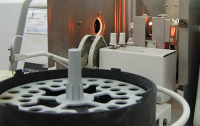A.-M.-PIAGET 50 · CP 979
CH-2301 LA CHAUX-DE-FONDS
Tél. + 41 (0)32 967 80 00
contact(at)laboratoiredubois.ch

Nickel release test
It is estimated that 10 to 20% of women and 1-3 % of men suffer from a nickel contact allergy. It is important to highlight that it is not the presence of nickel that causes the allergy, but the nickel salts forming under the effect of sweat in contact with an item (jewel or watch). This phenomenon is always associated with the corrosion of the item.
Nickel sensitisation is irreversible, so once a person is sensitized, any item in continuous close contact with the skin may cause an allergy. This may involve everyday items, depending on the quality of the metal or the coating: earrings, necklaces, watch bracelets and clasps, spectacle frames, chains, rings, watch cases, zip fasteners, buttons, piercings, etc...
The survey conducted by the Swiss Confederation, published in 2008, highlights that more than 20% of the items analysed were disputed, and that costume jewellery often releases quantities of nickel in excess of the threshold value.
Laboratoire Dubois SA has acquired a solid experience in determining the quantity of nickel ions released by an item in the presence of synthetic sweat. It has contributed to the development of various detection methods and the drafting of standards in force; it is a member of the "Nickel allergen" working group of the Swiss Watchmaking Industry Federation (FH), and of the "Allergenic materials" Swiss mirror group.
At European level, Appendix XVII of the REACH regulations, substance No.27, defines the authorised nickel release threshold, i.e. 0.5 micrograms of nickel per cm2 (surface area of the piece) per week, for items in direct and prolonged contact with the skin. This migration threshold is reduced to 0.2 µg/cm2/week for piercings.
In Switzerland, it is the Order on items designed to come into contact with the human body which sets the nickel release requirements, with the same migration threshold values as the REACH regulation.
Our laboratory is ISO 17025 accredited and equipped to perform the three tests as per the standards/methods in force.
- Standard EN 12472 sets out the wear and corrosion simulation conditions to apply prior to determining the nickel released by items comprising a coated base metal. This test simulates 2 years' normal use of the item; it is applied prior to the EN 1811 test. Many jewels are guaranteed nickel allergy risk-free for a period of 2 years after the purchase date, despite coating wear.
- Standard EN 1811 describes the reference test method for nickel release assessment for products designed to come into direct and prolonged contact with the skin. For spectacles items, standard EN 16128 is applicable.
- Report CR EN 12471 of the CEN (European Committee for Standardisation) describes a qualitative method for identifying nickel release by rubbing on the item with a cotton bud soaked in a revealing agent.




